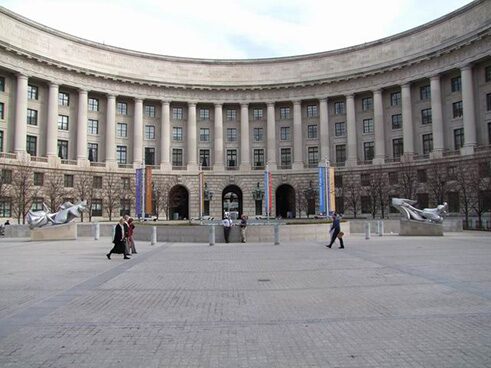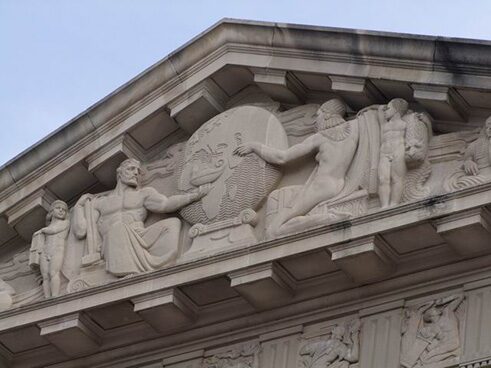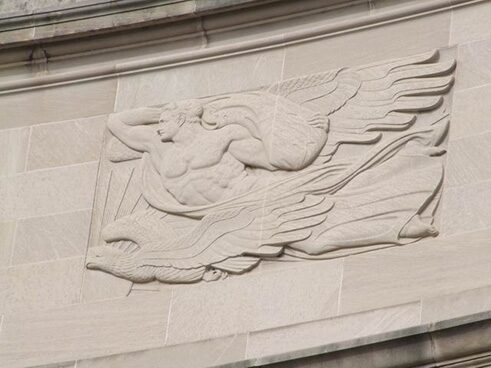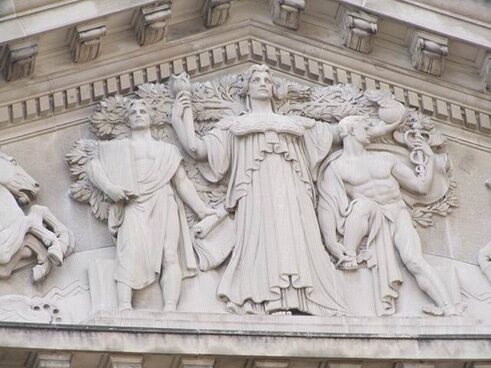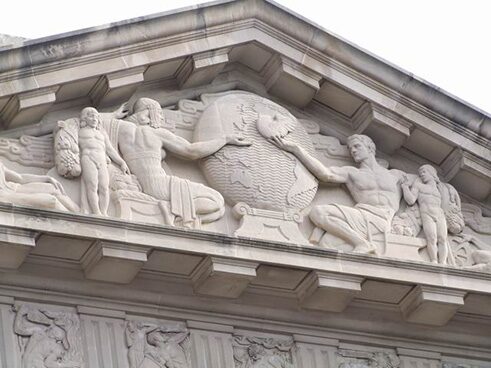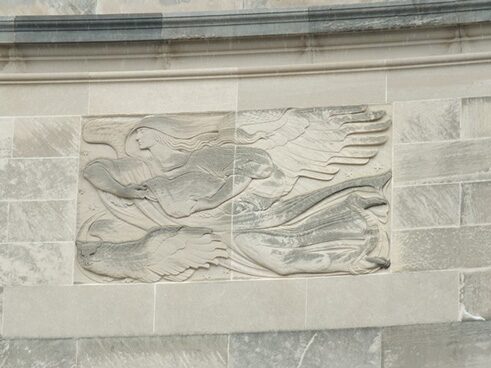Former Post Office Department / Ariel J. Rios Federal Building
German Roots in DC
-
The front of the former Post Office Department building, 2009. -
Intercommunication Between the Continents of Europe and Africa, North Pavilion, 2009. Note: some sources say this work is by George H. Snowden (1902-1990). -
The Transmission of the Mail by Day and by Night, West Façade, North - Day, 2009. -
The Spirit of Civilization and Progress, East Façade, 2009. -
Intercommunication Between the Continents of America and Asia, South Pavilion, 2009. Note: some sources say this work is by George H. Snowden (1902-1990) -
The Transmission of the Mail by Day and by Night, West Façade, South - Night, 2015.
The idea for a group of monumental governmental buildings in the Federal Triangle started to become reality with the Public Buildings Act of 1926. Before the plan's substantial completion in the mid-1930's, however, the realities of the Great Depression had almost led to its demise. Certainly, the radically changed economic and social conditions of the nation led many citizens to question the validity of selecting such a grandiose style to represent a democratic society's government. Younger generations of Washingtonians have learned to take the grandly monumental style of the Federal Triangle buildings for granted; they scarcely even notice it. But in 1937, when the Federal Writers' Project published its guide, Washington: City and Capital, Weinman's work for the then new Post Office Department is described in awed detail. The solidity made palpable in the Beaux-Arts classical art style--along with its ties to ancient European tradition--were perhaps evidence that the country, its economy, society, and political institutions were durable, despite the unrest, insecurity, poverty, and human suffering so visible to Depression-era Americans:
The architectural sculpture . . . portrays the development of the postal service in relation to the process of civilization. The earlier forms of communication are depicted in the Doric frieze on the western façade by bas-relief panels which are repeated along the pavilions and within the semicircle. These are smoke and blanket signals of the American Indian, the ancient helio signal, the carrier pigeons of antiquity, the drum message of the savage, and finally the Security of the Mail. The corner bas-reliefs show two genii supporting the fasces of united government.
The figures in the two pediments of the pavilions represent the four continents and symbolize the transfer of human knowledge. The central motif in each case is a hemisphere, flanked by heroic seated figures and genii. The north pediment portrays Europe as a Thor-like male figure offering the Lamp of Knowledge to Africa, a beautiful and exotic female figure. The genii of Europe and Africa are represented by male children of those continents. The reclining end figures are a Grecian woman with the sibylline sphere, and an inscrutable Egyptian figure with urn and crocodile. The south pediment shows America, a vigorous nude male, handing the Winged Sphere of Speed to a semidraped woman, the Orient. Each figure is accompanied by an appropriate genius. The end figures are a nude man and hooded nude woman, both reclining on beasts native to the continents represented. On each pediment are two corner eagles, symbolic of speedy communication.
Just within the semicircle, on the attic parapet near the two pediments, are bas-reliefs on Night on the north, and Day on the south, with an inscription covering the parapet wall between them. [Actually, it's the other way around: The Delivery of the Mail by Day is on the north and The Delivery of the Mail by Night is on the south.]
Above the central portico of the east façade there is an elaborately sculptured pediment depicting the Spirit of Progress and Civilization, holding aloft a torch and winged sphere; at her right stands a youth with scroll and book, the bearer of the Written and Printed Word; at her left, Mercury, messenger of the gods, is fastening his sandal, symbolic of the post as Quickener of Commerce. To the left of the central group are two impatient steeds, held in check by a powerful male figure, symbolizing Transmission of Post by Land, and on the right, a balanced group of seahorses guided by a Triton, and accompanied by dolphins, denoting Transmission of Mail by Sea. The end group on the right is a virile male figure and winged genii guiding and controlling the wires of Electrical Communication; that on the left portrays a reclining winged figure with eagles, emblematic of Transmission of Mail by Air. Here again are corner eagles.
Similar in design to the pediments of the west façade, the pediment on the Pennsylvania Avenue façade also has the central motif of a hemisphere encircled by a band and supported by two youths, one handing the other the Torch of Knowledge. The end figure, left, is a Triton with dolphins, and right, an aviator with eagle. The pediment symbolizes the bond of postal union.
Artists and citizens today certainly squirm at some of Weinman's allegories, but these artworks are at the contradictory heart of the monumental Washington created in the Federal Triangle in the late 1920's and 1930's. Standing in the large open courtyard between the west side of the former Post Office Department and the east side of the Ronald Reagan Building and International Trade Center, dedicated in 1998 (completing the Federal Triangle), the visitor has an opportunity to contemplate seventy years of monumental art and architecture and think about the links between art and power in a democracy.
Adolph Weinman, Sculptor and Medalist
Born in Karlsruhe in 1870, Adolph Weinman emigrated to the United States as a ten-year-old and attended public schools in New York. At 15, he was apprenticed to a sculptor and attended evening art classes at Cooper Union and, later, the Art Students League. The prominent sculptor Augustus Saint-Gaudens noted Weinman's talent and later invited the young artist to become an assistant in his studio. Weinman was also an assistant to German-American sculptor Charles Henry Niehaus. Saint-Gaudens was influential in introducing Weinman to the art world and helpful in getting the younger man commissions for various kinds of work creating sculptures and medallions. His work adorns many buildings around the country. In New York, his best known works include the pediments for the Municipal Building (McKim, Mead and White, 1907-1914), friezes for the exterior of the Morgan Library, and the bronze doors fo the American Academy and Institute of Arts and Letters.He was a member of the American Academy and Institute of Arts and Letters, the Architectural League of America, the National Academy of Design, the New York City Art Commission, and the National Sculpture Society, serving as the society's president from 1927 to 1930. He died in Port Chester, New York in 1952.
Weinman's papers are housed at the Archives of American Art.
These notes summarized from an article by Lois Goldreich Marcus in the American National Biography (1999).
